Road surfaces: types and materials
by Piotr Mazurowski, on March 07, 2024
The focus of attention on any well-designed road is its surface, a critical component that influences durability, safety, and overall performance. In the UK, where road networks crisscross diverse terrains and must cope with fluctuating weather conditions, understanding the distinct types of road surfaces and methods used in their construction and maintenance is crucial.
Read on to learn more and use these links below to find the section you are most interested in:
- What is a road surface?
- What are the different types of road surface materials?
- Permeable vs non-permeable road surfaces
- Factors influencing road surface selection
- How long does a road surface last?
- The types of road surface maintenance methods
- Design and evaluate road-build projects with Tensar+
If you’re ready to discover how Tensar InterAx geogrids can increase the lifespan of road pavements, get in touch today.
What is a road surface?
A road surface is the upper layer of the road pavement, serving as the interface between vehicles and the underlying structure. This critical component is designed to withstand the impact of traffic, weather conditions, and other environmental factors.
Road surfaces are engineered to ensure durability, safety, and optimal performance. They play a crucial role in providing a smooth and safe driving experience, whilst also contributing to the overall pavement resilience.
With several types of road surface materials available, understanding the drawbacks and benefits of each is crucial for evaluating the viability and longevity of your road construction project.
What are the different types of road surface materials?
Asphalt
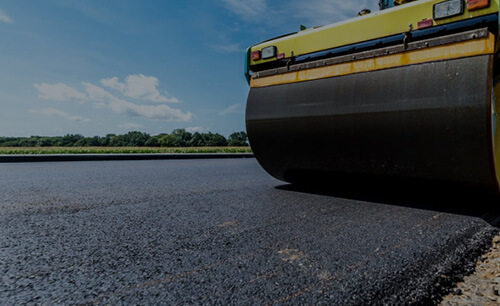.jpg)
Asphalt, also known as blacktop, is an umbrella term that covers a range of mixes used within the construction industry. The correct term is asphalt concrete. All asphalt concrete mixes use bitumen as a binder to cement together the aggregate particle components of the mix. Types of aggregate can include gravel, crushed rock, sand, or gravel. Other components such as polymers, fibres, or crumb rubber may be added to the mix to modify its properties.
| Benefits of using asphalt | Disadvantages of using asphalt |
| Quick to apply due to the fast-curing nature of asphalt. |
Over time heavy traffic can lead to rutting and fatigue cracking |
| Flexible – able to tolerate some settlement and deformation. |
The production and installation create greenhouse gases contributing to environmental pollution. |
| Long lifespan when adequately maintained. |
Susceptible to freeze-thaw damage |
| Easy to repair. |
|
| Low tyre noise |
Whilst the benefits of asphalt make it an incredibly popular choice for roads in the UK, it can be prone to rutting and cracking if preventative measures are not taken. Tensar asphalt reinforcement products like Glasstex®Grid-R pavement reinforcement provide a solution to cracking, helping to improve the performance and durability of road pavements.
Concrete
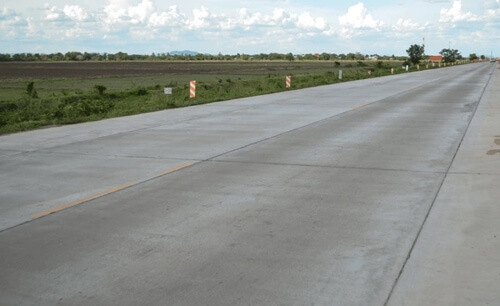.jpg)
Concrete is one of the most traditional road surfaces and its presence can be traced as far back as Roman times. The compressive strength and rutting resistance of concrete makes it particularly suited for roads subject to high wheel loads or where vehicle speeds are low. Concrete is commonly adopted for toll plazas, commercial vehicle parks, loading bays, and container handling areas.
Concrete roads are not as popular in the UK, and most of the UK’s network of roads, including motorways, are surfaced with asphalt. Some roads are built of concrete, and they make up around 400 miles (4%) of England's motorway and long-distance A-road network.
| Benefits of using concrete | Disadvantages of using concrete |
| High strength and stiffness | Higher initial cost than asphalt |
| Highly durable - unaffected by freeze thaw conditions, elevated temperatures, or fuel spills | High energy and carbon cost of the manufacturing process |
| Long service life | The rigidity of concrete can cause cracks in the surface if poorly supported. |
| Difficult to repair. |
Bituminous seals and slurries
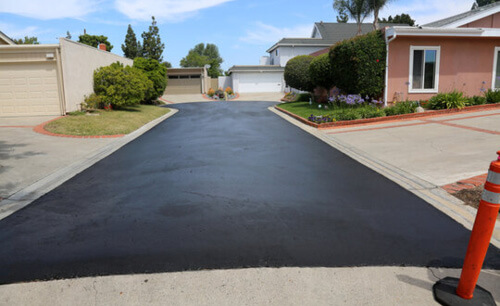.jpg)
Bituminous seals and slurries can be effective surface solutions for low volume rural roads. Single layer applications are not very durable and are likely to be uneconomic. Double layer applications are more effective and preferred.
Sand Seal – A bitumen seal coat is sprayed on the surface followed by a thin layer of sand or fine aggregate, which is rolled in. A second application placed within 6 to 12 months improves durability.
Double Surface Dressing – A bitumen seal coat is followed by a dressing of 19mm size aggregate. This is then followed by a dressing of 7mm size aggregate to create a dense surface.
Slurry Seal - A mixture of fine aggregate, Portland cement and bitumen emulsion binder, with added water to achieve a creamy consistency. This is spread to a thickness of up to 15mm.
Cape Seal – A single surface dressing followed by one or two layers of slurry to produce a dense, impermeable surface.
| Benefits of using bituminous seals and slurries | Disadvantages of using bituminous seals and slurries |
| More waterproof than unsealed roads | Shorter lifespan compared to asphalt. |
| Cheaper than asphalt alternatives | Damaged by heavy trafficking. |
| More durable than gravel surfacing | Susceptible to cracking followed by rapid failure. |
| Simple construction - can be manually applied. | Can have lower skid resistance than asphalt. |
Gravel
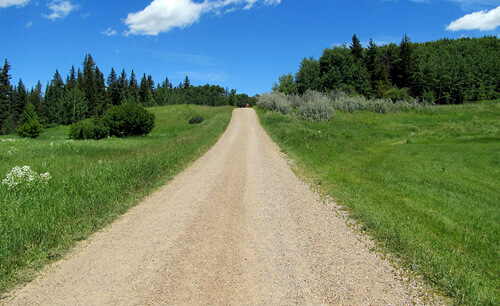.jpg)
Gravel roads are often referred to as unsurfaced roads, but this is misleading. A more appropriate description is unsealed roads. A well-constructed gravel road is in fact an engineered natural surface road. The gravel surface is selected, and in some cases blended, for the purpose of protecting the structural base layer and providing a smooth ride quality. Regular maintenance is necessary to maintain the ride quality, prevent erosion and repair low spots.
| Benefits of using gravel | Disadvantages of using gravel |
| Low cost | Requires regular maintenance. |
| Easy to maintain | Poor surface friction |
| Well suited for low-traffic areas | Generates considerable amounts of dust and stones. |
| Can be sealed at a later stage | Not suitable in areas prone to high rainfall |
| Unsuitable for steep gradients |
Block paving
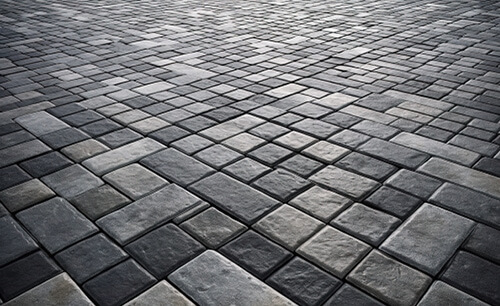-(1).jpg)
Block or cobble paving using stone sets has been around for centuries. The technique is still popular in cities and urban environments, though expensive. The advent of factory-made concrete blocks has reduced the cost of block paving. The availability of assorted colours and textures has made this type of surfacing popular for use in residential developments and lower speed roads in urban areas. Block paving has also proven suitable for heavy duty pavements in airports and container handling facilities. Permeable block paving systems are being favoured for large, paved areas such as car parks. More on this below.
| Advantages of block paving | Disadvantages of block paving |
| Very low maintenance costs | More expensive than concrete surfacing, for low volume roads |
| Highly durable | Blocks can loosen and become a trip hazard if not maintained. |
| Unaffected by frost or fuel spills | Weed growth in joints can become unsightly in low use areas. |
| Aesthetic appeal – wide colour and texture range | Trenching for surfaces – block replacement requires a high level of care. |
| Easy to visually segment areas – e.g. parking zones or cycle ways |
Permeable vs non-permeable road surfaces
Most road surfaces are designed to be impermeable. A key function is to prevent water entering the pavement where it can lead to weakening of the lower pavement layers. Permeable paving seeks to do the opposite. The surface is designed to allow water to drain away from the surface, flowing down into the base layer. The base layer is designed to allow that water to flow laterally into drains or storage voids. In some cases, some of the water is temporarily stored within the porous base material.
Regular maintenance is essential for all permeable road surfacing to maintain permeability and fitness for purpose.
Why do we need permeable road surfaces?
With ever increasing awareness of the need to build flood resilience into our infrastructure, permeable pavements are a solution to reduce stormwater runoff from paved areas. By allowing storm water to penetrate the road surface, the water can be stored and released slowly into the stormwater drainage system and into local water courses. Permeable pavements are an integral part of a well designed sustainable urban drainage system (SUDS). In China, the term ‘sponge city’ has been adopted to describe urban design that focuses on absorbing rainfall to prevent flooding.
What road surfaces are permeable?
Concrete block paving systems designed to provide vertical flow channels between adjacent blocks are now commonly used for residential and commercial roads, and parking areas, as well as pedestrian areas.
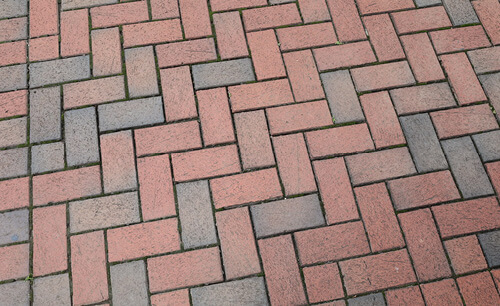
Permeable block paving system
Open graded, polymer modified, permeable asphalt mixes are available for both base course and surface course. The use of polymer modifiers in the mix improves resistance to tyre scuffing and from the effects of freeze-thaw cycles.
.jpg)
Permeable asphalt (source Tarmac)
Permeable concrete is also available. The open graded mix design allows water to flow through. Use of this type of surfacing is currently limited and tends to be for parking areas and driveways. The lower strength compared to regular concrete roads makes it unsuited to higher vehicle loading. As will all permeable surfacing, regular maintenance is essential to prevent clogging.
Factors influencing road surface selection
With many different road surface types available, there are multiple factors to consider when choosing an appropriate material for your project. No two road-build projects are the same and varied factors will need to be considered.
Traffic volume and type
Traffic volume and vehicle loading are of key importance when selecting pavement surfacing. The predicted traffic over the service life, including changes to vehicle weight and type, need to be assessed. Similarly, vehicle speed needs to be considered. Both concrete and asphalt are equally suitable for high volume roads. Slurry seal, surface dressed, or block paved roads are unsuitable for high volume roads. Concrete or block paving is well suited to low-speed high-load areas, such as truck parks, industrial roads, toll plazas, and container handling facilities.
Costs
Cost is undoubtedly one of the factors most considered when choosing a surface material. Not only should the initial construction costs be considered, but also the costs to maintain and repair the road throughout its usable life.
For example, whilst concrete roads have a high initial construction cost, they require less maintenance and have a longer life expectancy compared to asphalt. However, when repairs are required, concrete is more difficult and expensive to maintain than asphalt.
Climate and weather considerations
Temperature and rainfall will influence the choice of surfacing. Large temperature fluctuations can lead to shrinkage cracking in concrete pavements, while periods of elevated temperature result in softening and rutting of asphalt surfacing. High temperatures accelerate the ageing (oxidation) of asphalt reducing flexibility and service life. Freeze-thaw cycles can lead to accelerated deterioration of asphalt, particularly if it is already cracked due to fatigue or other factors.
Asphalt has a high albedo value – it absorbs solar radiation and then releases that heat over time raising local air temperatures. Lighter, concrete surfaces reflect solar radiation. Concrete surfacing can therefore provide a valuable environmental role by contributing less to air temperature rises in urban areas.
Maintenance
A reliable transport network is vital in any community and minimising traffic disruption on congested networks is key, during both the initial construction period, and later when undertaking necessary maintenance. To reduce disruption caused by maintenance works, choosing a durable road surface material, one able to support the traffic over the full-service life, would be the ideal solution.
Concrete pavements offer the longest service life, with minimal maintenance requirements. However, this comes at a higher construction cost compared to asphalt surfaced pavements.
Asphalt requires regular maintenance, including periodic re-sealing of the surface. Fortunately, maintenance of asphalt is relatively easy to carry out. Any asphalt material removed during resurfacing can be recycled. Various additives can be used to enhance the life of asphalt surfacing. Asphalt reinforcement products are available to increase the life of asphalt surfacing and asphalt overlays, reducing whole-life costs. Discuss this with the Tensar team for advice on the most appropriate solution for your requirements.
How long does a road surface last?
All road surfaces start to deteriorate from the day they are installed. Concrete road surfaces are by far the most durable with a life expectancy of up to 40 years. Little maintenance is required, but some work will be necessary to address spalling at joints, cracking over weak spots, and traffic abrasion.
Asphalt surfaces degrade due to oxidation of the bitumen binder. This ageing process results in a loss of ductility and increased susceptibility to cracking. Cracks allow water to ingress, weakening the lower pavement layers, leading to pavement rutting, fatigue cracking of the asphalt, and development of potholes. Water freezing in the cracks can accelerate deterioration during freeze-thaw cycles.
-(1).jpg)
All pavements start to deteriorate from the day they have been installed (source TLHO)
The life of asphalt pavements can be prolonged by planned periodic maintenance that includes re-sealing or resurfacing. With planned maintenance an asphalt road may be expected to last 20-30 years.
What are the types of asphalt road surface maintenance methods?
Over time, asphalt road surfaces require maintenance and repairs to preserve them and ensure that they remain safe for road users. There are several methods and techniques available, and the type chosen will depend on the current condition of the road’s surface.
Road/pavement renewal
Pavement renewal involves the complete replacement of the existing road surface, and possibly the base and subbase layers, making way for the installation of new materials. This comprehensive approach is the most expensive and disruptive option available and aims to enhance the overall durability and performance of the road.
.jpg)
Pavement surfacing - Installation of Tensar AX5-GN prior to the asphalt overlay
Surface dressing
Surface dressing involves spraying liquid bitumen followed by a layer of stone chippings, which is then rolled to embed them within the bitumen. The main purpose of surface dressing is to extend the life by re-sealing the asphalt, and to improve surface friction.
Pavement slurry seal
For slurry seal, a mixture of bitumen emulsion, fine aggregate, filler, and water is sprayed over existing pavement surface in a single coat up to a thickness of 6mm. This method aims to re-seal the pavement surface and provide improved skid-resistance. This is a relatively low-cost solution which can revive the existing pavement, enhancing its appearance and texture.
Full-depth reclamation or retreading
Retreading involves taking up the existing surface, recycling it and mixing it with bitumen or cement before rolling it to create a firm base. A surface layer of asphalt is then applied. This method is not suitable for heavily trafficked roads. The main benefit is that it helps to reduce waste by reusing existing materials.
Asphalt Preservation
This method involves spraying a sealant treatment onto the existing asphalt to rejuvenate the surface, providing a protective seal, inhibiting water ingress and oxidation. The treatment can be used as part of the road asset management plan, significantly extending pavement life. There are two types of preservation treatment:
Penetrative treatments – These are solvent based treatments comprising a blend of bitumen, dilutants and plasticisers. They are designed to achieve penetration and rejuvenation of the binder coating.
Non-penetrative treatments – These comprise a blend of bitumen, polymers, and other additives. They are designed to seal and protect the road surface.
Micro-surfacing
Micro-surfacing, sometimes called micro-asphalt, is very similar to slurry sealing, except that a polymer modified bitumen is used, and the application is in two layers, up to a final thickness of 15mm. Whilst a slurry relies on the evaporation of water to speed up the drying process, micro surfacing hardens through the chemical additives without the need for heat or sun to encourage evaporation
Design and evaluate road-build projects with Tensar+
The service life of all road surfacing types is dependent upon the stiffness and support provided by the pavement layers below. The use of stabilisation geogrids in the unbound pavement layers can improve structural support, increasing the pavement life. With the road design module in our design software platform, Tensar+ software helps design engineers visualise and evaluate the parameters and requirements of pavement construction projects. Discover how Tensar+ and Tensar InterAx geogrids can enhance your road construction projects.
.jpg)
The use of asphalt reinforcement products in overlays when resurfacing roads, particularly those with surface cracks, can increase the overlay life. Tensar asphalt interlayer products are designed to mitigate cracking and increase the fatigue life of overlays.
Want to learn more?
Eager to deepen your understanding? Explore our other articles:
- Road construction: pavement types, methods, and designs
- What are the functions of layers in a flexible pavement?
- Asphalt vs tarmac: what’s the difference?
- Freeze Thaw Weathering and Degradation: The Effect on Road Pavements
- What causes potholes?
- Harnessing the power of pavement optimisation for housing projects
- Designing road foundations to DMRB-CD225



.jpg?width=400&height=400&ext=.jpg)